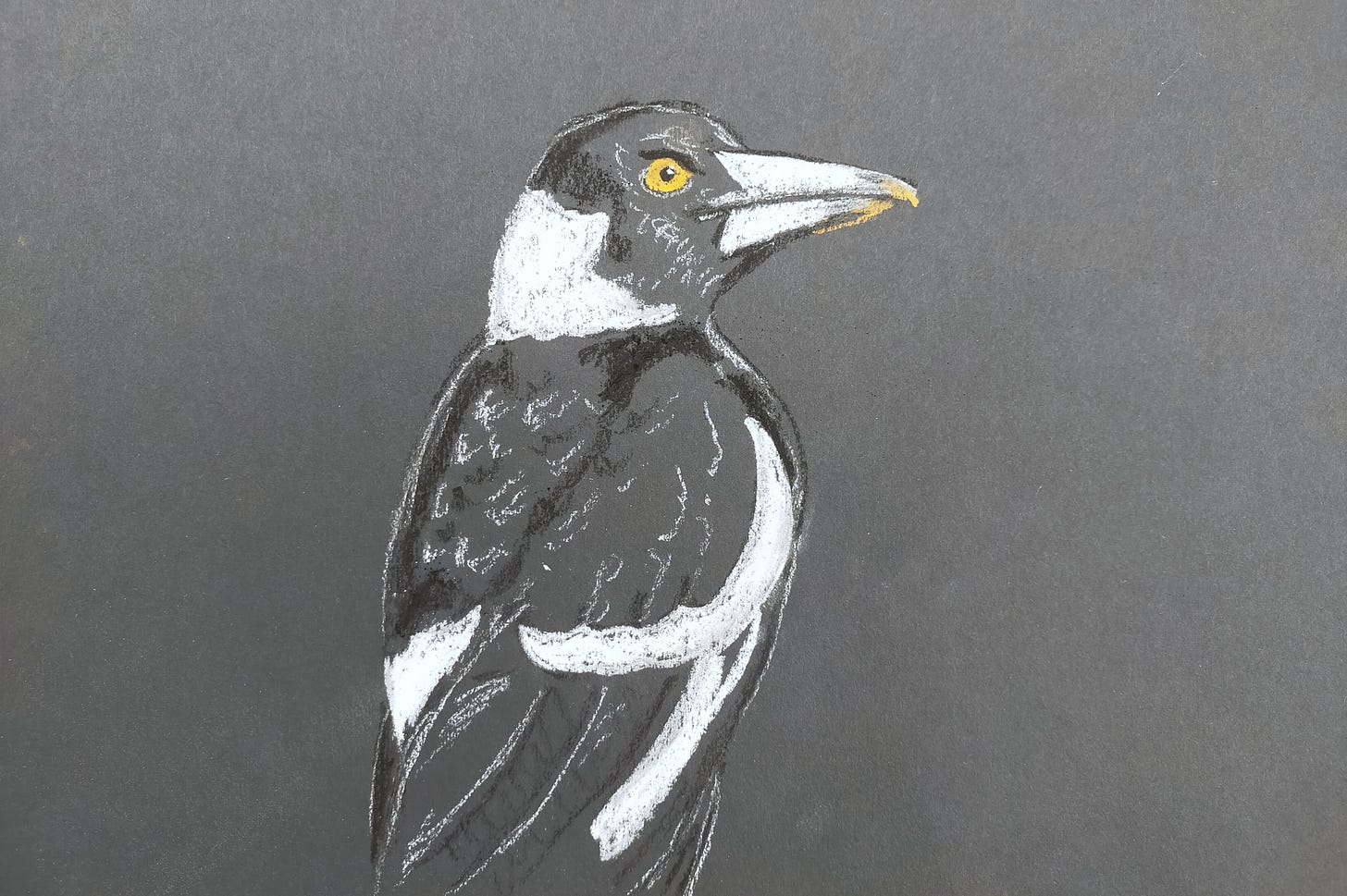The magpie has been picking the fibres out of the doormat on my back deck, a pleasant turn of events because it means nesting season has arrived. I don’t mind. It’s done it for the past three years, quite ingenious really because who wouldn’t like a little tropical coconut fibre in their alpine home. Besides, the mat is in tatters; I really should buy a new one. The other morning while dismantling the doormat, the magpie looked up and saw me smiling and, with a beak full of coir, did its best ventriloquist impersonation, warbling some sort of excuse or explanation or apology. Very sweet that it felt it needed to do so.
A short while later, it was back, picking out dried parsley strands from beneath the grevilia (my garden is, well, let’s be kind and call it interesting). It hopped onto the deck and strutted up to the cat lazing in the sun. Caspian was pleasantly amused because it’s rare his favourite species would be so brazen as to come within a paw’s reach. But he was cautious and careful not to undo his sprawl; he knows better than to mess with a magpie, and I should warn here for the non-Australians among us that it would be wrong to confuse the Australian magpie with the smaller northern-hemisphere birds of the same name. They are not closely related. Our magpies are both feared and adored, insanely intelligent, vicious and kind, and absolute bosses of their domain. The magpie stared at Caspian for a good moment then casually walked past his head and flew off to build its nest in the gum tree.
Dear Caspian. If only he knew how prized his fur is among the birds this time of year—the magpies and the white-winged choughs—it’s the ultimate in luxury nest insulation. Then he would have realised that the magpie was weighing up its chance of escaping unscathed if it were to quickly pluck a little fur from his fat belly.
That fury animals begin to moult right as birds build their spring nests is a wonderful convenience of nature.
The magpies within whose territory I live have black backs with a white patch behind their necks. There’s an old Bangerang story that explains that two neighbouring clans each had a set of mischievous identical twins, one male pair and one female. So that people could tell them apart, white ochre was painted on the backs of one from each pair. One day the two pairs met, fell in love and were allowed to marry. The twins with white ochre backs married each other, as did the ones without ochre. It wasn’t long before they were all causing mischief again, pushing the clans to the brink of war. But Byamee the sky god came crashing down in the thunder to intervene. He turned the twins into magpies and cast them into the sky, telling the white-backed magpies to stay in the south and the west, and the black-backed magpies to keep to the north and the east. South of my home beyond the mountains, the magpies have white backs.
My black-backed magpie was back Monday morning collecting more of everything for its nest and I wondered how its little construction project had held up in the night’s downpour. Leaving my breakfast, I brushed a palmful of fluff from Caspian, for which he was very appreciative, stretching long and purring. One cool cat, one less furball and one warm baby bird. I flattened it into a felt pancake and, as the magpie was off making a delivery, placed it on the back step where the bird had been foraging. Amusingly, some of my own hair lay damp on the step and I wondered how it managed to excavate that from the dirt archives. Such thorough little creatures. Long hair can tangle a nestling, so I cleared it away then turned my attention to a pot plant that had been pummelled in the storm. Almost instantly, the claws of a little four-toed foot tapped the deck behind, the magpie having lost not a moment in securing its prize. It walked towards me with the fur in its beak and paused, a gesture I’d like to think meant thank you but perhaps served the more likely purpose of checking to see if I had any more, then it turned and walked off behind the house.
Another magpie family often visits our yard, but only to the north side of the house. I suspect they are related to family that reside here because they can often be seen pecking at insects together in the neighbour’s paddock. There are others, too, who live in the surrounding bush and come to visit on Meeting Days. Meeting Days are when all the magpies in the vicinity come to stand in a circle outside my bedroom window and discuss community matters. It’s said they have their own justice system in which an offending magpie stands in the middle of a circle of its peers, which step forward one by one to peck it in punishment. I haven’t witnessed such corporal retribution, but I have watched as certain individuals take turns to strut into the circle’s centre, state their case (sometimes silently), then return to their place. Once, one of the birds got a single peck from another, then they both returned to their places. Was justice served? Or was it unfairly accused? I’ll never know, but I do love witnessing the formality of these Meeting Days.
So nesting season has arrived. It takes days to build a nest. So much care and effort to ensure the structure won’t collapse. It would be a sad sight to see a pale blue egg smashed on the ground. It’s the source of life, and it will be protected at any cost.
My husband gets uncomfortable right about now as it marks the start of the swooping season, the time of year when ordinary humans walk across parklands holding sticks in the air, paint eyes on the back of their hats, and tie zip ties to their bicycle helmets as if they were Roman gladiators entering a battle arena. Magpies will draw blood to protect their nests, which I think is quite endearing. They are the ultimate helicopter parent. Unfortunately, some magpies in public spaces take it a little too far, attacking everyone, and according to Magpie Alert (the national swoop database), swoop season 2025 has begun.
Our garden magpies don’t swoop us. On the contrary, they seem to regard us fondly. They know us by our faces. We give them fur for their nests, water in the heat of summer, a garden full of edible life, and leave them to sunbake in all manner of strange positions, burning off the parasites in their feathers with their wings spread wide and their legs in the air—appearing dead to the world but just asleep, fully trusting in us and the safety of our garden to doze in such vulnerable positions. I don’t know if I’m imagining it, but I feel they grew more trusting in us once our children were born. They know all about fierce love for their offspring and I’d often see them watching mine from above. Sometimes, on summer evenings when the sun stays up late, they sit outside the open window and sing with me as I croon my daughters to sleep. They have a magnificent repertoire, one of the world’s finest. The first time it happened I thought it a lovely coincidence, but time has proven otherwise. It is a magical thing to sing with a magpie, just as it is an honour to share this place with them. This little patch of land is as much theirs as it is ours, and I couldn’t imagine ever telling them otherwise. I would have to be an absolute fool.
Thank you for Mind Flexing with me. If you enjoyed this essay, please subscribe on Substack or your favourite podcast app, comment, click the ❤️ button, or share it with someone who would appreciate it. I’ll be back in a fortnight. Until then, keep 💪













